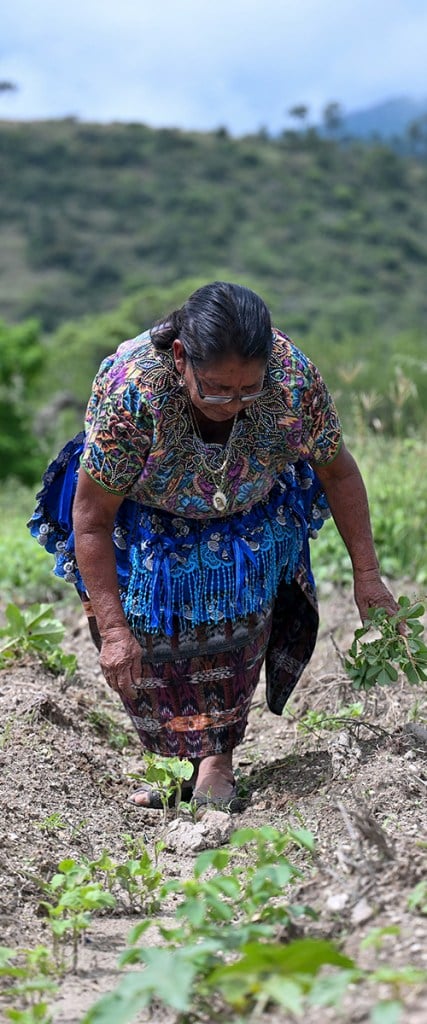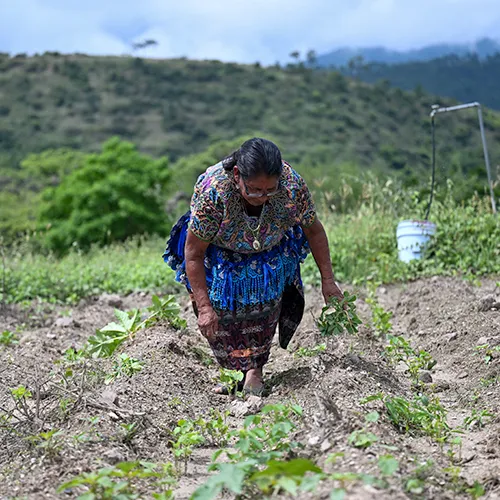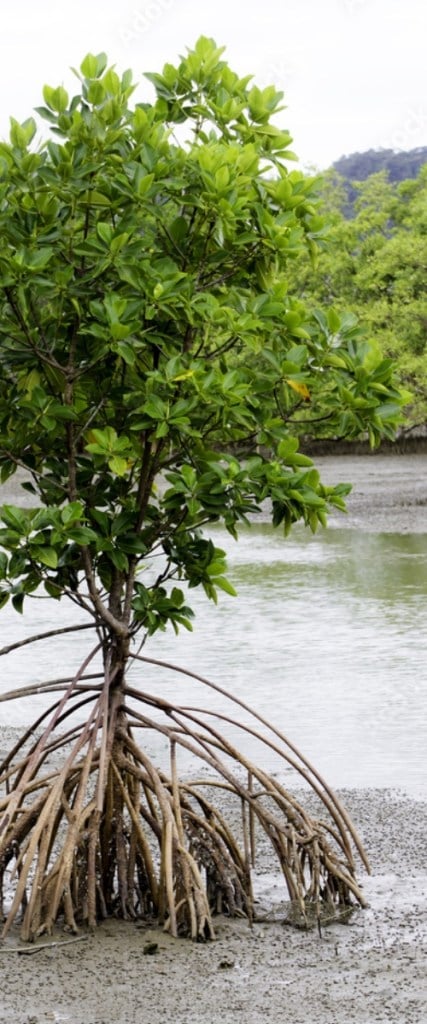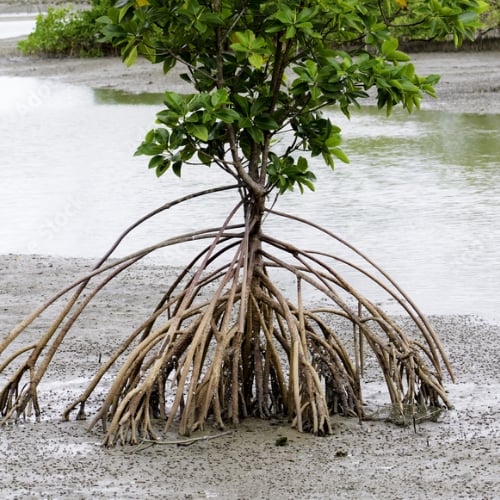Accelerating Nature-Based Solutions to Climate Change Through Women’s Leadership
Opportunities to galvanize action at COP28 to maximize environmental and socioeconomic impacts
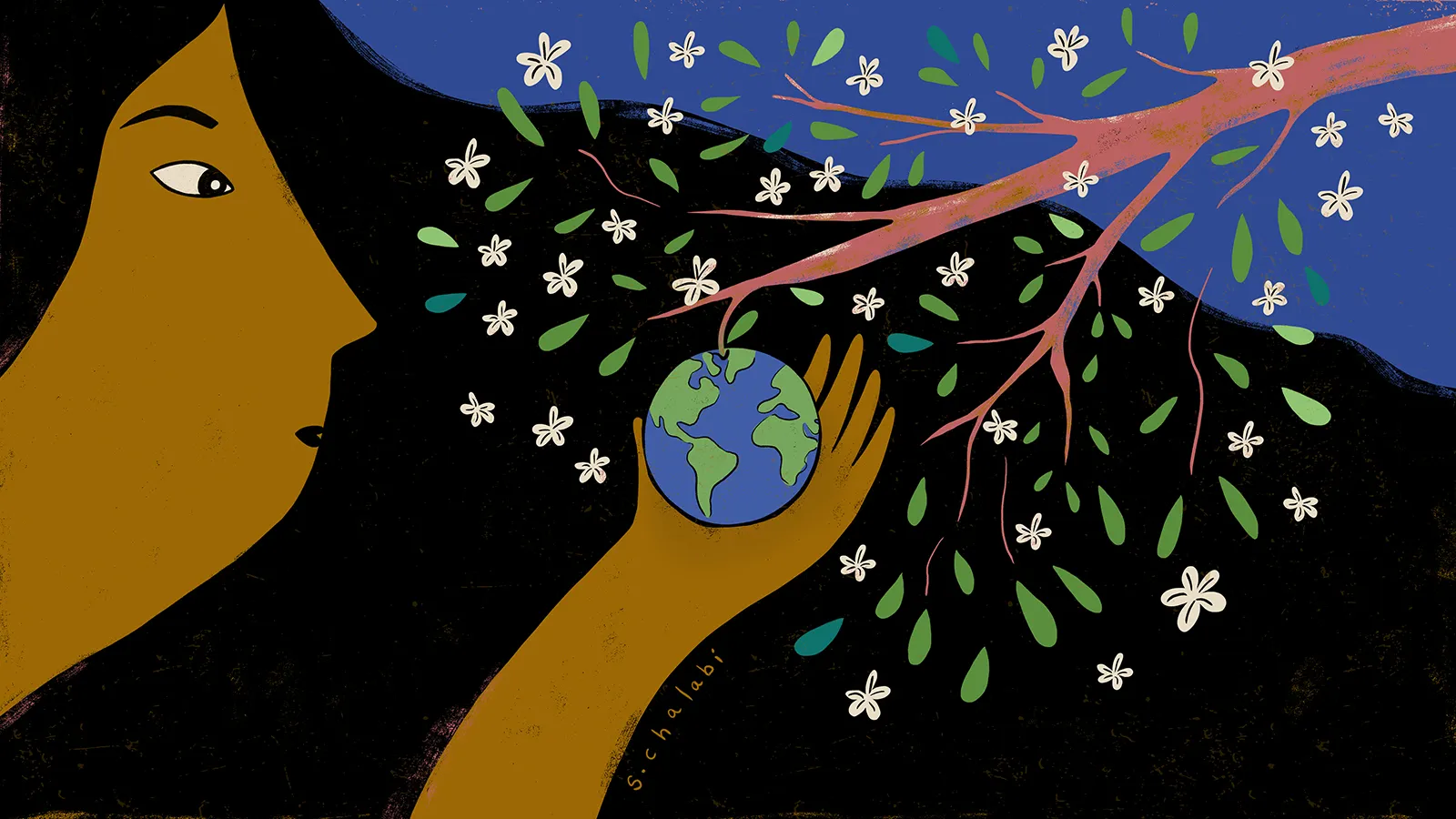
An issue brief by FP Analytics, with support from Daughters for Earth and Vital Voices
November 2023
Women-led climate action and nature-based solutions (NbS) represent transformative pathways for climate mitigation and adaptation, both demanding a systems-wide reassessment of how to manage resources responsibly. A growing body of evidence shows that women-led solutions, and particularly NbS, are key to meeting the 2015 Paris Agreement targets, along with many of the United Nations Sustainable Development Goals (SDGs) by 2030. Women smallholder farmers—when able to access the same resources such as time, financing, land tenure, and extension support as men—are able to boost agricultural yields by 20 to 30 percent, leading to a 2.5 to 5 percent increase in total agricultural output, and a projected 2.1-gigaton reduction in green house gas (GHG) emissions by 2050. Meanwhile, women-led innovative technologies, such as Eco Wave Power and Origen Air, are creating new climate-mitigation and -adaptation opportunities.
Women smallholder farmers—when able to access the same resources such as time, financing, land tenure, and extension support as men—are able to boost agricultural yields by 20 to 30 percent.
Focusing climate action, including NbS, through a gender perspective at all levels of society, and across all sectors, is critical to address climate change effectively. Yet, today, only 0.2 percent of overseas climate finance reaches women-led efforts, while NbS remain underprioritized and underfunded. Although world leaders formally committed to increasing investment in NbS at COP26 and adopted the COP15 Kunming-Montreal Global Biodiversity Framework, financing for NbS in 2022 remained at just $154 billion, well below the $484 billion investment per year necessary to meet climate goals by 2030. The impact of women-led climate action and nature-based solutions can be amplified in combination. To unlock the full potential of NbS, policymakers and investors need to sustain funding and target resources to optimize environmental and socioeconomic impacts, the key to which is scaling up women-led climate action.
As the global community convenes at COP28 in Dubai to take stock of progress and recommit to a more sustainable future, expanding women-led initiatives, particularly NbS—alongside the expansion and deployment of renewable energy, deep decarbonization, and other innovative solutions—can be game-changing for building climate resilience and promoting inclusive growth. Not including women in climate action leaves value and effective solutions on the table at a time when every moment counts to avert climate catastrophe. This brief examines the powerful returns on investment in women-led climate action and how NbS represent an effective mechanism to elevate women’s leadership and roles in climate change and achieve urgent climate goals.
Nature-based solutions are underleveraged in climate adaptation and mitigation. Investing in women-led efforts can maximize their environmental and socioeconomic impacts.
Cross-cutting research shows that women adopt innovations that help others and produce social impact, act as investors in their households and communities, and are deeply connected to, and knowledgeable about, their local environments, effectively leveraging and protecting natural resources. Nature-based solutions (NbS) are approaches that mitigate climate change and promote biodiversity, by protecting ecosystems from loss or degradation, restoring ecosystems that have already been lost or degraded, and managing productive land more sustainably. In addition to making various sectors more climate resilient, NbS reduce emissions, capture carbon dioxide, protect biodiversity, and can deliver a wide range of additional positive benefits. If widely utilized, nature-based solutions could provide around 30 percent of the cost-effective mitigation needed to stabilize warming to below two degrees Celsius by 2030.
In addition to their critical role in climate mitigation, strategically deployed women-led NbS can have multiplier effects that help advance progress on health- and gender-related SDGs, and contribute to economic development. For example, investing in NbS at recommended levels is estimated to create 191 million jobs by 2030, contributing to progress toward a just energy transition. Additionally, NbS such as the planting, protecting, and managing of mangroves can not only filter clean water, protect biodiversity, and reduce soil run-off, but also reduce coastal vulnerability to extreme weather events and other climate impacts. However, current investment in NbS stands at less than half of what is necessary to meet climate goals by 2030, underscoring the need to drive widespread investment and support local and Indigenous communities who are the stewards of NbS.
Increasing the uptake and usage of NbS will necessitate accelerating the leadership and participation of women: Women represent 43 percent of the global agricultural workforce, rising to 60 percent or more in low- and middle-income countries (LMICs) across the global south, where they comprise the majority of smallholder farmers. Additionally, women are stewards of ecosystem services such as water and firewood supply, with specialist, often Indigenous, knowledge of how best to manage, maintain, and protect those resources. Investing in women has demonstrated impacts for wider communities and societies, creating a multiplier effect that will benefit more than the local environment. Women re-invest up to 90 percent of their earnings into their families and communities, in particular ensuring that their children can access an education, and thus increasing human capital, productivity, and economic development in the long term.
Alongside scaling up investments, structural barriers to women-led climate action need to be dismantled to unlock the potential of nature-based solutions
Despite the proven benefits of NbS as well as women’s leadership in climate mitigation more broadly, both issues are neglected in private and public lending and investment. In 2020 only 8 percent of impact investment funds addressed SDG 5, on gender equality, and only 2 percent of venture capital went to women-owned businesses, while in 2021, female farmers received only around 7 percent of investment in agriculture. Furthermore, while multilateral development banks are actively working to integrate a gender-lens into their lending and projects, an internal review of World Bank lending operations from 2012 through 2021 found that only 65 percent of projects with an element of NbS had a focus on gender inclusion. When disaggregated by region, the challenge becomes clearer: Only 32 percent of NbS projects in Africa had a gender-lens, although 62 percent of smallholder farmers in the region are female. A recent study of climate funding additionally found that only 17 percent of funding intended for Indigenous communities actually reaches them, and further, only 5 percent of that reaches Indigenous women.
Fewer than one-fifth of landowners globally are women, and women still lack the legal or cultural right to inherit their husbands’ land in over 100 countries, as of 2023.
Source: UNCCD 2023
Women also face several cultural and legal barriers to participation and leadership in NbS, as with other climate-resilience approaches. The most pressing of these is lack of land rights: despite their integral role in agriculture and food production, globally fewer than one-fifth of landowners are women, and women still lack the legal or cultural right to inherit their husbands’ land in over 100 countries, as of 2023. Ownership or named tenancy over the land they are working would enable women to implement new and proven NbS techniques that would improve productivity while protecting ecosystems and reducing carbon emissions, such as regenerative agriculture or agroforestry. Indeed, in research released in 2023, the UN Convention to Combat Desertification (UNCCD) identified equal land rights as critical to the achievement of entwined gender and climate goals by 2030. Women are also often excluded from strategies and payment schemes relating to ecosystems services despite undertaking the majority of these activities, particularly in LMICs. Recognizing that addressing these broader obstacles will be key to accelerating women’s leadership within NbS and climate action, policymakers at COP28 need to keep a focus on overcoming cultural and legal barriers alongside mobilizing funding in partnership with the private sector.
Multisectoral partnerships are key to mobilizing capital for nature-based solutions to generate inclusive growth and build climate resilience
Coming two years after the formal recognition of the role of NbS in mitigating warming and other climate impacts, COP28 represents a critical opportunity for world leaders, multilateral institutions, and investors to prioritize NbS within climate finance plans and agreements, and scale-up public and private investments in women-led and other under-represented groups. While NbS alone cannot deliver the entirety of the emissions reductions needed to meet the Paris targets, they are a proven strategy to be deployed alongside other techniques and innovations, and in many cases are already being utilized. Accelerating NbS, and women’s leadership implementing them, will now require greater commitment of funds, and the integration of women-led NbS into broader climate-mitigation and carbon-capture schemes by governments, multilateral institutions, and the private sector, including through cross-sectoral partnerships.
CASE STUDY
PROTECT
Women in coastal Vietnam conserve mangroves to reduce extreme weather risks
The Vietnamese coastal province of Thua Thien Hue has repeatedly suffered from extreme weather, which has caused significant damage, and stunted the economic growth of the region. Vietnam’s Ministry of Natural Resources and the Environment has projected that if emissions remain at their current high levels, rising temperatures will cause an increase in annual rainfall of 2 to 10 percent, and a 94-cm rise in sea levels, threatening the low-lying province and its ability to produce floods efficiently. In response, supported by the Vietnam Women’s Union, women in Thua Thien Hue are planting and restoring mangroves to act as sea defenses and protect productive soil from run-off and erosion, and to preserve shrinking mangrove ecosystems. In 2018, the Women’s Union partnered with local and international funders to implement Resil-Nam Coastal, which was granted $500,000 to undertake planting and capacity-building activities. By 2021, the women involved in the project had planted over 12,000 mangrove seedlings throughout the province, leading to an estimated return on investment of $2.30 for every $1 invested. This ROI includes savings from reduced flood damage, enhanced ability to fish, and profits from increased eco-tourism, but it does not include the value of carbon stored in the mangroves, which was estimated at around $35,000.
CASE STUDY
MANAGE
Indigenous farmers in Guatemala spread regenerative farming methods
The woman-led and -founded Alliance for International Reforestation (AIR) has been working with farmers in Guatemala, particularly its Indigenous communities, since 1991 to spread and scale up reforestation and regenerative agricultural methods, with the aims of protecting water supply, building soil health, preventing natural disasters, and improving crop yield. Since 1993, AIR has worked with over 5,000 smallholder farming families and has supported the planting of 7.7 million trees. AIR works over a five-year program structure, embedding in local communities to better understand their needs and ambitions for their land, re-introducing regenerative agricultural practices—many of which originated within the Indigenous communities being supported—and supporting rural microbusinesses through capacity-building and grants. Women are additionally benefited via AIR’s cookstove replacement scheme, which seeks to improve health outcomes and reduce air pollution.
There are clear pathways to accelerate women-led NbS. Multilateral institutions are mainstreaming gender targets into their project plans and funding schemes, setting clear targets that seek to transform unequal power structures disadvantaging women, ramp up resource mobilization, and grow participation in training and leadership opportunities. In some cases, this takes the form of dedicated funds and programs within broader climate funding program. For example, while not specific to NbS, the Climate Investment Fund (CIF) Accelerating Coal Transition Investment Programme—which supports a just energy transition by working with communities reliant on coal to build local buy-in and repurpose coal energy infrastructure for green energy generation—includes a targeted Women-Led Coal Transition program. This sub-program dedicates resources and grant funds to test and identify innovative and creative models by which to support women-led organizations directly during the energy transition. Financing mechanisms focused on NbS could create similar dedicated funds and programs to ensure women-led action by design and from the outset.
As national governments create and prioritize climate policies and agendas, they have a critical role in promoting equitable leadership and participation in climate action, and specifically in women-led NbS. In 2021, the International Union for Conservation of Nature (IUCN), found that 78 percent of the 89 available and updated Nationally Determined Contribution (NDC) plans explicitly included one or more mention of gender, up from just 40 percent of NDCs in 2016. While this progress is promising, a regional breakdown indicates that highly industrialized countries, including across North America and Western Europe as well as Australia, are lagging, with just half including some mention of gender, compared to 100 percent of NDCs in Latin America, and 94 percent in sub-Saharan Africa. Indeed, as of 2019, only around two dozen countries globally had published dedicated climate change gender action plans (ccGAPs), despite their relevance in guiding and focusing gender-sensitive climate action. In addition to better integrating gender equity into climate-mitigation strategies, more targeted funds and greater resources are required for effective implementation alongside higher prioritization of NbS.
CASE STUDY
RESTORE
Costa Rica prioritizes women-led forestry in national climate action policy
Costa Rica provides an example of a country that is seeking to accelerate women-led NbS and ensuring that women benefit from the funding and resources available, which could be instructive to countries of all economic levels. In 2016, the implementers of the country’s REDD+ plan—the UN-led framework to reduce emissions from deforestation and forest degradation, as part of the Paris Agreement—created a Gender Action Plan (GAP), in acknowledgment of both women’s critical leadership in forest stewardship and their historic exclusion from climate plans and funds. Utilizing focus groups and workshops to understand the needs and ambitions of Costa Rican women involved in NbS, and partnering with the National Institute for Women (INAMU), the Costa Rican REDD+ GAP analyzes gaps and opportunities in support for women smallholders, Indigenous women, and women enacting NbS at the grassroots. The GAP identifies clear goals for transforming power structures that marginalize women’s expertise agency, and leadership and advancing gender equality as part of national climate action, including increasing the number of farms owned and operated by women, promoting and facilitating financial mechanisms that benefit men and women equally for conservation of natural habitats, and promoting the restoration and management of forests. Costa Rica’s REDD+ plan will be implemented alongside its ongoing work to reverse deforestation, and other ambitious environmental policies, led by the Energy and Environment Minister, Andrea Meza.
CASE STUDY
RESTORE
The Green Belt Movement plants trees across sub-Saharan Africa
Founded in 1977, the Green Belt Movement (GBM) was started by Professor Wangari Maathai, in partnership with the National Council of Women of Kenya, in response to urgent reports from rural Kenyan women that their streams were drying, their food supplies were becoming less secure, and they were walking further distances to collect firewood. To address these issues, which threatened women’s livelihoods and health, as well as the local environment, GBM paid Kenyan women to plant trees and grow seedlings in their communities and on their land, in order to restore degraded watersheds, mitigate soil erosion, and provide food and firewood. Around Nairobi, GBM has worked with over 10,000 farmers, including women, to plant trees and implement agroforestry techniques, protecting and restoring over 260 km of the Tana River ecosystem, and leading to a 40 percent increase in agricultural yields. In recognition of her work, Professor Maathai received the Nobel Peace Prize in 2004. Today, GBM has planted over 51 million trees in Kenya alone, making use of technologies such as GIS, and it has expanded its reach through the Pan African Green Belt Network, including in Ethiopia, Tanzania, Malawi, and Uganda, and led to over 30,000 women being trained in sustainable forestry practices, thereby generating both economic and environmental benefits.
CASE STUDY
MANAGE
Eco Wave Power harnesses the power of the ocean to generate clean energy
The private sector has a pivotal role to play in generating economic growth and setting norms and standards for sustainable and equitable business practices, yet to date it has been largely absent from investments in NbS or women-led climate action. Currently, only 17 percent of investment in NbS comes from the private sector, and women-led NbS thus represents a major area for growth and expansion. Private capital can be unlocked by de-risking investments in NbS, and particularly through the creation of public-private partnerships and initiatives that support innovation and enable smart business approaches that benefit people and the planet. As more companies define clear ESG and climate-mitigation objectives, NbS represents a dynamic and environmentally friendly avenue for investment. For example, the United States Agency for International Development (USAID) recently launched the Climate Gender Equity Fund (CGEF), in partnership with Amazon, with the aim of scaling financing to gender-equitable climate actions. The Fund focuses on women-led and women-benefiting organizations addressing climate change, and aims to mobilize an initial commitment of $60 million from other corporations, philanthropic foundations, and multilateral institutions to support female-led climate resilience. The private sector has, in recent decades, prioritized both gender equity and sustainability within core business practices and corporate social responsibility strategies; investing in women-led NbS could combine and accelerate these complementary agendas as part of future environmental and social commitments.
In 2021, 78 percent of the 89 available and updated Nationally Determined Contribution (NDC) plans explicitly included one or more mention of gender, up from just 40 percent of NDCs in 2016.
Source: IUCN 2021
Sectors and industries that could play a key role in supporting women-led NbS include food and agriculture, technology, energy, retail, and infrastructure. Built infrastructure is currently responsible for over 60 percent of global emissions and is a major driver of habitat and species loss, but an estimated 11 percent of necessary infrastructure could be replaced by NbS, such as planting or maintaining reefs and mangroves instead of sea wall defenses. Indeed, around half of climate-resilience infrastructure could be provided by NbS, and research has found that integrating NbS into infrastructure projects could save $248 billion per year of the projected $4.290 trillion being invested in infrastructure each year. National and municipal governments are beginning to recognize these benefits and integrate NbS into their infrastructure development plans. The Netherlands, for example, recently launched a 5.98 billion euro ($6.49 billion) green bond for nature-based climate resilience infrastructure. CitiesWithNature—a global multistakeholder initiative—has worked with over 300 city governments to integrate nature into city planning, with the goal of restoring degraded landscapes, improving air quality, and reducing emissions. Both initiatives could be strengthened by integrating an explicit gender equity strategy and dedicated funding pot, in order to ensure that women benefit and are sufficiently involved in the design and implementation of NbS.
Opportunities for growing women-led climate action at COP28 and beyond
When deployed in tandem with other climate-mitigation and adaptation strategies, women-led nature-based solutions represent a critical opportunity for the global community to effectively course correct on the 1.5-degree global warming cap, progress toward which can be significantly accelerated through support for women’s leadership. Women-led NbS can drive inclusive economic growth alongside responsible and sustainable environmental stewardship if paired with long-term investments, yet dedicated funds and strategies to scale-up climate action currently neglect the many potential benefits that women-led implementation holds. Indeed, the acceleration of women-led NbS can be most effective in conjunction with increased female inclusion and leadership at all levels of society and across all sectors engaged in climate mitigation and adaptation.
COP28 represents a critical juncture to devise constructive approaches to overcome barriers that to date have held back the full potential of NbS, including to scale up women’s leadership. In addition to lack of land and financial rights that prevent women from investing in themselves and their communities, lack of gender-disaggregated data on climate impacts and climate-related work prevents clear analysis of the impacts of ongoing NbS projects and investments. These gaps make it difficult to identify areas for growth and investment, and to track progress, all of which are critical to ensuring that financing is being deployed strategically, effectively, and continually. Additionally, while much of the work on NbS underway is taking place in LMICS across the global south, which to be sure is salient, high- and upper-middle income countries remain responsible for the majority of GHG emissions—almost 80 percent of emissions collectively as of 2021—yet have been slow to adopt and grow NbS, which can enhance other climate-mitigation and -adaptation efforts.
At COP28, global leaders, executives, and investors have the chance to reaffirm and renew their commitment to women-led climate action to mitigate warming and meet rapidly approaching climate and sustainable development targets. In particular, COP28 delegates need to prioritize the following:
- Identifying pathways for sustainable, long-term financing to continue and scale up existing women-led NbS programs, and to establish new ones in partnership with women, including Indigenous women and local communities;
- Mobilizing and scaling up private capital and public-private partnerships in equitable climate finance to amplify the returns of investment and improve sustainable business practices for women-led approaches; and
- Adopting targeted and ambitious commitments across the public and private sectors, in coordination with relevant civil society organizations, to invest in women’s leadership and equitable governance structures across all sectors.
Data and evidence from around the world demonstrate that women are powerful actors in achieving economic and environmental goals, from grassroots local action to corporate C-suites and government agencies. By investing in women-led climate action, the international community can maximize socioeconomic and environmental impacts while supporting women’s agency, innovation, and expertise to build a greener future.
By Isabel Schmidt (Senior Policy and Research Analyst) and Dr. Mayesha Alam (Vice President of Research). Illustration by Sawsan Chalabi for FP Analytics.

FP Analytics, the independent research division of The FP Group, produced this issue brief with funding from Daughters for Earth and Vital Voices, and supported by The Rockefeller Foundation. FP Analytics retained control of the research direction and findings. Foreign Policy’s editorial team was not involved in the creation of this content.

